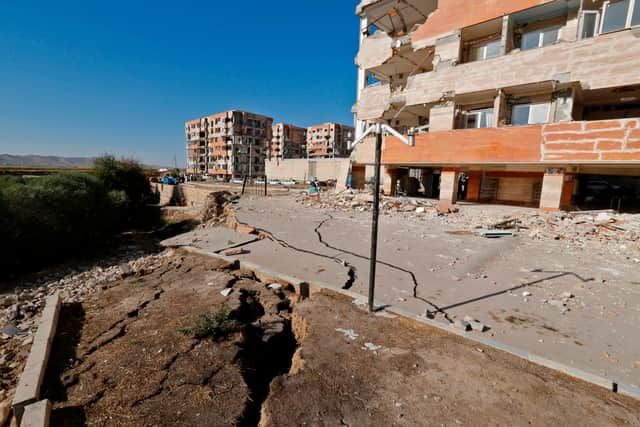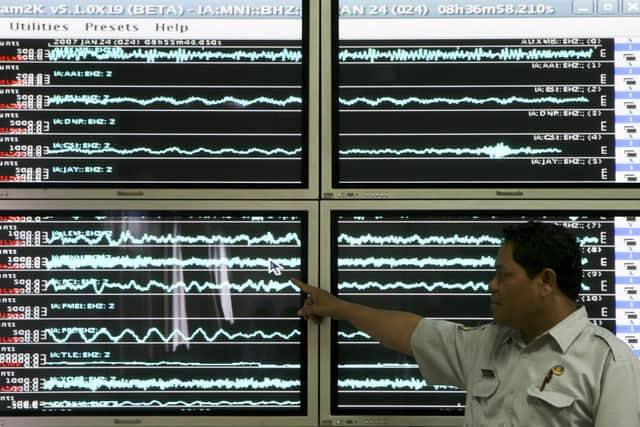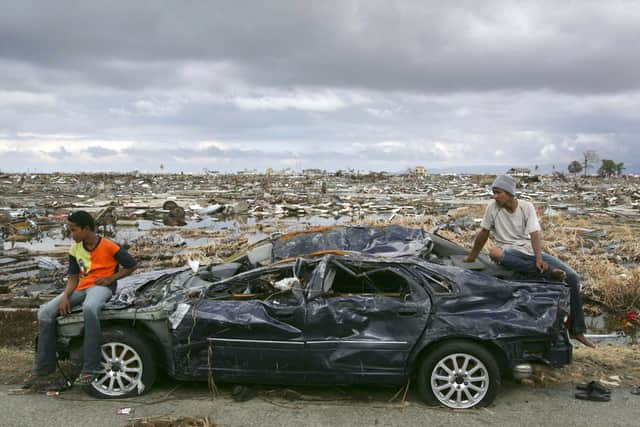How are earthquakes measured? What causes them, strongest quake in UK and when was worst earthquake in history
and live on Freeview channel 276
An earthquake registering 7.8 magnitude has hit Turkey and Syria causing the deaths of more than 1,700 people.
The quake was centred in the town of Pazarcik in Kahramanmaras province about 60 miles from the Syrian border outside the provincial capital city of Gaziantep. At least 20 aftershocks followed, with the strongest measuring 6.6 magnitude according toTurkish authorities.
Advertisement
Hide AdAdvertisement
Hide AdThe last big quake in the UK occured in May 2022 when a 3.8 magnitude earthquake was recorded in the town of Shropshire. Earthquakes are rare in the UK, with the British Geological Survey explaining quakes of this magnitude are only felt “roughly every two years.”
Quakes have hit the UK in the past, but it’s been a long time since the region was struck by one over 5 magnitudes. Here’s everything you need to know about what casuses earthquakes and what was the strongest earthquake to hit the UK.
What causes earthquakes?
The earth is made up of tectonic plates, which are huge pieces of the earth’s crust. These plates are always moving slowly, but when they get stuck, their edges begin to build up tension. When the build up of pressure becomes too much, the tectonic plates release it in waves, causing the jerky movements that people feel as earthquakes.


Earthquakes can cause catastrophic damage to buildings and have a deadly impact on human life. There are certain areas in the world where earthquakes are more common, due to the pressure that is put on the tectonic plates. The area around the rim of the Pacific Ocean has gained the nickname, “Ring of Fire” as 81% of the world’s earthquakes take place here due to the instability of the tectonic plates.
How are earthquakes measured?
Advertisement
Hide AdAdvertisement
Hide AdThere are a few ways that earthquakes can be measured. The most well known method is the Richter scale, which measures the magnitude of earthquakes, giving them a rating out of ten. The Richter scale finds the size of the quake by calculating its largest seismic wave by using a machine called a seismometer,which produces how powerful the quake is through a seismograph.


However scientists opt to now use the Moment Magnitude Scale as it is more accurate than the Ritcher scale. The Moment Magnitude Scale measures the total moment release of the earthquake instead and is more accurate with higher magnitude quakes.
What was the strongest earthquake recorded in the UK?
The strongest earthquake to hit the UK was the Dogger Bank earthquake in 1931, it reached a magnitude of 6.1 on the Richter scale and caused intense shakes. The quake was located in the North Sea, 60 miles off the coast of Yorkshire and caused damage to homes, with chimneys falling in Hull. There was only one fatality, a woman who reportedly had a heart attack during the earthquake. It’s also said that the quake was felt as far away as London, with the heads falling off some of the wax models at Madame Tussauds.
What are the worst earthquakes in history?
A 10 magnitude earthquake has never been recorded, but, there have been many powerful earthquakes that have shook the world, causing widespread devastation.


These are the top five, ranked by magnitude:
Valdivia, Chile - 9.5
Advertisement
Hide AdAdvertisement
Hide AdThe worst earthquake in history was the Valdivia Earthquake which hit off the coast of Chile in 1960 with a magnitude of 9.5. The most powerful earthquake ever recorded, it took place 100 miles off the coast of Chile near the city of Valdivia. It caused a 25 metre tsunami that struck the west coast of Chile and stretched as far as Japan and the Philippines and hit Hawaii badly, with the town of Hilo being completely destroyed. There is no official death toll, but estimates put it at around 6,000.
Great Alaska, US - 9.2
Also known as the Good Friday earthquake, this 9.2 magnitude quake hit Alaska in 1964. The most powerful earthquake to hit the US, it caused a 8.2 metre tsunami which devastated the town of Chenega. 139 people died in the catastrophe, including five people in Oregon and 13 people in California.
Sumatra, Indonesia - 9.1
The Sumatra earthquake took place on Boxing Day in 2004. It was one of the deadliest earthquakes causing over 250,000 deaths. The earthquake ruptured 900 miles of faultline, which resulted in a tsunami with waves of 30 metres, which hit the coasts of Indonesia, Sri Lanka, India and Thailand.
Tōhoku, Japan - 9.1
In Japan 2011 an underwater 9.1 magnitude earthquake triggered a tsunami which hit the north east of the country. The waves reached heights of 40.5 metres and caused meltdowns at three reactors in the Fukushima Nuclear Power Plant. The death toll was 15,894 with 2,562 people still reported missing to this day.
Kamchatka, Russia - 9.0
Advertisement
Hide AdAdvertisement
Hide AdAn earthquake off the coast of Kamchatka in north east Russia struck in 1952.It caused a 15 metre tsunami that damaged the coast of Kamchatka and left an estimated 10,000 - 15,000 people dead. The waves reached as far as Hawaii and New Zealand.
Comment Guidelines
National World encourages reader discussion on our stories. User feedback, insights and back-and-forth exchanges add a rich layer of context to reporting. Please review our Community Guidelines before commenting.
